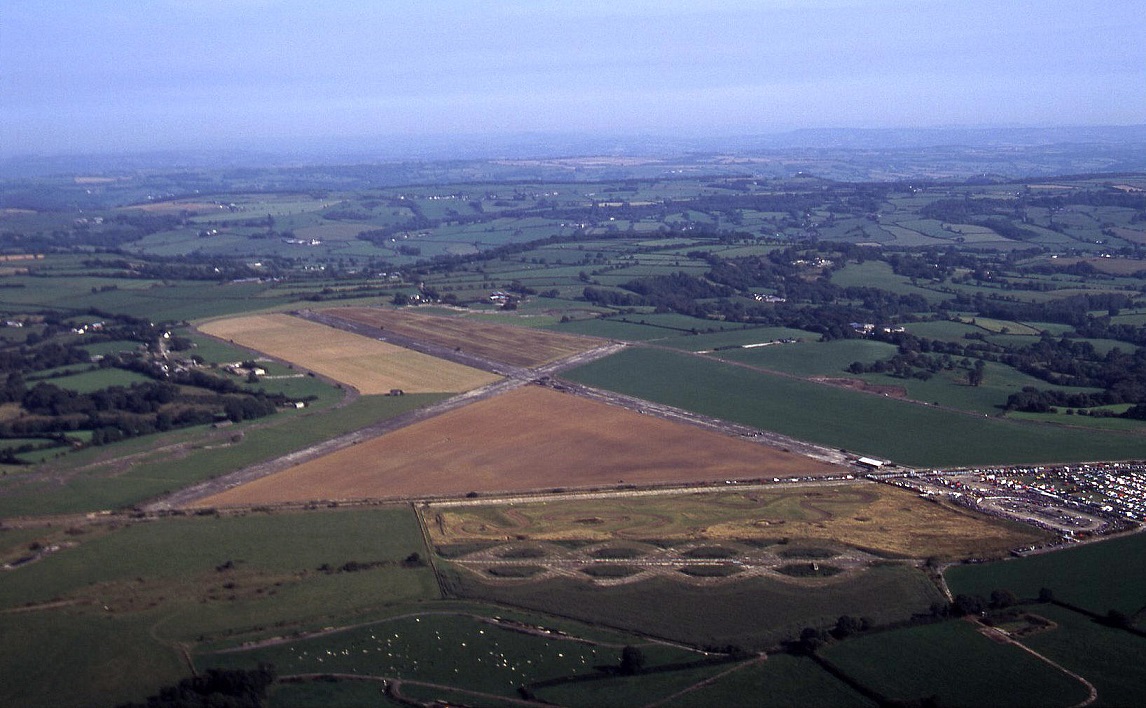Culmhead
CULMHEAD: Military aerodrome (Previously known as CHURCH STANTON)
Note: The first three pictures are by the author and taken through perspex. The first picture taken from a considerable distance, clearly shows a major event taking place. The fourth picture (2018) was obtained from Google Earth ©
Military users: WW2: RAF Fighter Command 10 Group
316 (Polish) Sqdn (Hard to say it appears - originally Hawker Hurricanes, then Vickers-Supermarine Spitfires and lastly North American P-51 Mustangs)
616 Sqdn (Vickers-Supermarine Spitfires later Gloster Meteors)
No. 3 GTS (Glider Training School) (General Aircraft Hotspurs)
Location: 6nm S of Taunton
Period of operation: 1941 to 1946
Runways: 03/21 1289x46 hard 09/27 1033x46 hard
15/33 1052x46 hard
NOTES: It might seem rather odd considering its geographical location, (nobody seems capable of explaining the most peculiar mindset of most senior RAF staff during WW2), but 616 Sqdn at RAF CULMHEAD was selected to be the first operational jet squadron. To quote from Robert Jackson in his book Britain’s Greatest Aircraft: “It has often been stated, quite erroneously, that Germany’s Messerschmitt 262 was the world’s first operational jet fighter. In fact, that honour fell to the British Gloster Meteor, which was fully operational a full two months before the first Me. 262 Staffel was formed in October 1944.” On the other hand the first steps to make the Me. 262 operational were made in April 1944 and an attack on a RAF Mosquito is recorded for the 26th July. Being of a cynical mindset I immediately thought: “Ah ha, but which of these types first saw combat - surely the Me. 262 considering the panic measures then being carried out by the Nazi regime?” It seems I was correct, the first recorded ‘successful’ combat mission was by Meteors from RAF MANSTON in KENT against V.1 ‘Doodlebugs’on the 4th August 1944.
THE JET AGE ARRIVES
“It was in June 1944 that the Royal Air Force entered the jet age, and the squadron selected to pioneer its entry into the new era was No.616, based at CULMHEAD, near Taunton in Somerset. Since the spring of 1944 there had been strong rumours that No.616 was to rearm with a radical new aircraft; most of the pilots however believed that if re-equipment did take place it would be with Griffon-engined Spitfire Mk.XIVs, and this belief was strengthened when, early in June, two of these aircraft arrived at Culmhead. Then, suddenly there was fresh speculation when, in the middle of June, No.616’s commanding officer, Squadron Leader Andrew McDowall, and five of the squadron’s pilots were sent on detachment to the Royal Aircraft Establishment at Farnborough. It was not until they arrived that McDowall and his colleagues learned what awaited them: a conversion course to Gloster Meteor Mk.1 jet fighters.”
“No.616’s first Meteor, EE219, arrived at Culmhead on 12 July 1944, the day on which, as a matter of coincidence, the German V-1 offensive began against Britain. During the next few days, eleven more Meteors were flown in from Farnborough and the task of converting the rest of the squadron’s pilots to the new type continued. Without exception the pilots found the Meteor delightful to handle; the main problem, after flying for years in tail wheel aircraft, lay in getting used to the tricycle undercarriage.” Later on it was discovered that the Meteor was in fact a very dangerous aircraft to fly and many pilots died before the precise handling techniques in certain circumstances were fully understood. This said the Meteor had a better record than the de Havilland Vampire which, (can this really be correct?), when first in squadron service, had an attrition rate of about 90% of pilots being killed before ending their first tour on the type. I have met a survivor who confirms this was indeed the case, at least when he served at RAF Coltishall (NORFOLK).
THE METEOR LEGACY
The Gloster Meteor record is, it appears, 900 lost in service and 450 pilots killed. It is well worth investigating the history. One aspect seems clear enough, the heads of the design team at Gloster were so full of their own importance they deliberately ignored advice from their test pilots. Today, surely, these people should now be named and shamed? Indeed, I now suspect if it was happening today, a very convincing case of ‘corporate manslaughter’ could be brought to bear? If you doubt this, please read Empire of the Clouds when the author, James Hamilton-Paterson tells the story behind one of his favourite test pilot heros, when working for Gloster, the Canadian Bill Waterton, who was very outspoken regarding the serious problems he foresaw with the Meteor entering RAF service.
RADIO RESEARCH
Are the British totally brilliant when it comes to radio stuff? Here again this aerodrome later became yet another radio research station. In compiling this guide I am totally amazed by the number of aerodromes which have, since WW2, become ‘radio research stations’. I wonder just what sort of research goes on in all these establishments?
We'd love to hear from you, so please scroll down to leave a comment!
Leave a comment ...
Copyright (c) UK Airfield Guide



















